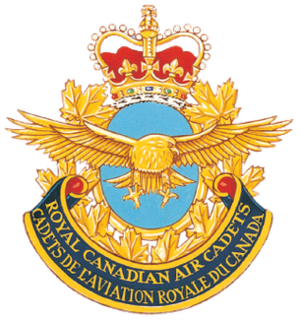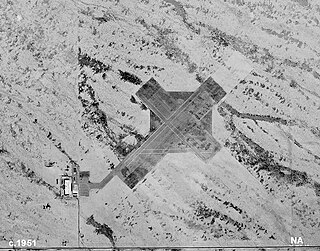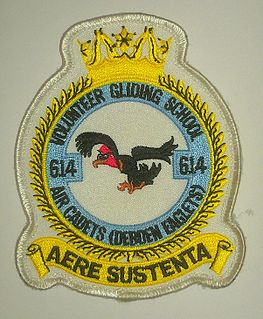
In most countries one is required to obtain a glider pilot license (GPL) or certificate before acting as pilot of a glider. The requirements vary from country to country.

The Royal Canadian Air Cadets is a Canadian national youth program for young individuals aged 12 to 18. Under the authority of the National Defence Act, the program is administered by the Canadian Forces (CF) and funded through the Department of National Defence (DND). Additional support is provided by the civilian Air Cadet League of Canada (ACL). Together with the Royal Canadian Sea Cadets and Royal Canadian Army Cadets, it forms the "largest federally funded youth program in the country". Cadets are not members of the military and are not obliged to join the Canadian Forces.

The Civil Aviation Authority (CAA) is the statutory corporation which oversees and regulates all aspects of civil aviation in the United Kingdom. Its areas of responsibility include:
A motor glider is a fixed-wing aircraft that can be flown with or without engine power. The FAI Gliding Commission Sporting Code definition is: a fixed-wing aerodyne equipped with a means of propulsion (MoP), capable of sustained soaring flight without thrust from the means of propulsion. In the US, a powered glider may be certificated for up to two occupants, up to 850 kg maximum weight, and with a maximum ratio of weight to wing span squared of 3 kg/m2. Similar requirements exist in European JAA/EASA regulations, at a maximum weight of 750 kg.
The Glider Pilot, Liaison Pilot, and Service Pilot badges were qualification badges of the United States Army Air Forces issued during the years of World War II to identify a rating in one of three specialized, limited-duty pilot categories whose selection and training differed from that of the traditional military pilot.

The Air Training Corps is one of the three corps in the New Zealand Cadet Forces, the other two being the Sea Cadet Corps and New Zealand Cadet Corps. It is funded in partnership between the RNZAF and communities, and its members are civilians. Members have no obligation to head into the regular force, however, some do choose to join the New Zealand Defence Force. Unlike the United States Civil Air Patrol, service as an ATC cadet does not translate into higher pay, rank, or seniority in the NZDF.
The British Gliding Association (BGA) is the governing body for gliding in the United Kingdom. Gliding in the United Kingdom operates through 80 gliding clubs which have 2,310 gliders and 9,462 full flying members, though a further 17,000 people have gliding air-experience flights each year.
The Gliding Federation of Australia (GFA) is the governing body for the sport of gliding in Australia. It was founded in 1949. The GFA is responsible to Civil Aviation Safety Authority for the conduct of safe gliding operations in Australia. This includes the setting and maintenance of flying standards and in particular training standards. It provides services to its members such as:

The Soaring Society of South Africa (SSSA) is the body to which all gliding and touring motor gliders in South Africa must belong, as stipulated in law by the South African Civil Aviation Authority (CAA), to pursue the sport of gliding within South Africa. It is affiliated to the Aeroclub of South Africa which also represents all the sporting bodies at the CAA. Membership is by subscription directly to the SSSA.

Volunteer Gliding Squadrons (VGSs) are Royal Air Force (UK) Flying Training units, operating military Viking T1 conventional gliders to train cadets from the Royal Air Force Air Cadets.
Philip Aubrey Wills CBE was a pioneering British glider pilot. He broke several UK gliding records from the 1930s to the 1950s and was involved in UK gliding administration including being Chairman of the British Gliding Association (BGA).

Wycombe Air Park, also known as Booker Airfield, is an operational general aviation aerodrome located in Booker, Buckinghamshire, 2.4 nautical miles south-west of High Wycombe, England. The airfield celebrated its 50th year of opening on 25 April 2015. It originally opened in 1941 as RAF Booker and was primarily involved in training during World War II, remaining a military establishment until 1965.

Gliding is a recreational activity and competitive air sport in which pilots fly unpowered aircraft known as gliders or sailplanes using naturally occurring currents of rising air in the atmosphere to remain airborne. The word soaring is also used for the sport.

The Directorate General of Civil Aviation (DGCA) is the statutory body formed under the Aircraft (Amendment) Bill, 2020. This directorate investigates aviation accidents and incidents, maintains all regulations related to aviation and is responsible for issuance of licenses pertaining to aviation like PPL's, SPL's and CPL's in India. It is headquartered along Sri Aurobindo Marg, opposite Safdarjung Airport, in New Delhi. The Government of India is planning to replace the organisation with a Civil Aviation Authority (CAA), modelled on the lines of the American Federal Aviation Administration (FAA).

Echeverria Field is an abandoned airfield, located approximately 15 miles (24 km) west of Wickenburg, Arizona.

During World War II civilian flying schools, under government contract, provided a considerable part of the flying training effort undertaken by the United States Army Air Forces.

614 VGS is a Volunteer Gliding Squadron based at Robertson Barracks, Swanton Morley in [Norfolk], United Kingdom. One of 27 Volunteer Gliding Squadrons, it is made up of between 40 and 60 personnel who annually conduct around 6,000 launches, producing more than 800 hours airborne. The squadron is currently operating under No.3 Flying Training School, within No.22 (Training) Group of RAF Air Command.

No.2 Flying Training School is a Flying Training School (FTS) of the Royal Air Force (RAF). It is part of No. 22 (Training) Group that delivers glider flying training to the Royal Air Force Air Cadets. Its headquarters is located at RAF Syerston in Nottinghamshire and gliding takes places from several sites throughout the UK using the Grob Viking T1. The RAF Central Gliding School is also under its command.













